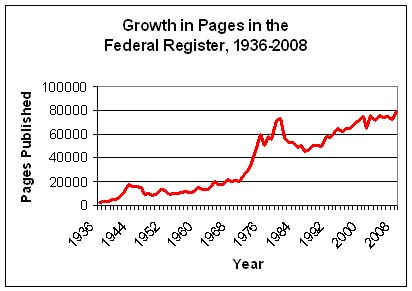
The Regulatory Review recognizes the contributions of the federal government’s “daily newspaper.”
July 26, 2010, will mark the 75th anniversary of the passage of the Federal Register Act (44 U.S.C. Ch. 15), which created the federal government’s daily “newspaper” of record, the Federal Register.
In light of the recent major legislative overhauls of the health care and financial systems, noting the establishment of the Federal Register as a uniform system for publishing government documents may seem rather quaint. But it is difficult to overstate the foundational importance of the Federal Register, particularly in an era of expanding governmental regulatory authority.
Published each weekday by the Office of the Federal Register (OFR), the Federal Register compiles and organizes the thousands of rules, regulations, executive orders, presidential documents, and notices generated each year by the alphabet soup of federal departments and agencies.
Without the Federal Register, government would lack a core transparency. Interestingly, for almost 160 years of America’s history, no uniform system existed for publishing governmental decisions. Each governmental department would publish regulations and notices in its own “gazette,” if it even did publish them at all. Often government officials themselves did not know where to find regulations, and ordinary citizens and businesses faced even greater difficulty knowing the rules under which government expected them to conduct their affairs.
The concurrence of several events in the 1930s created the conditions that led to the creation of the Federal Register as a uniform system of public notice. First, President Roosevelt’s New Deal programs generated unparalleled amounts of regulations, orders, and administrative rulings. Second, the American Bar Association published a report proposing a consolidated and organized publication of these documents. Finally, in January, 1935, the Supreme Court dismissed a prosecution of a legal action against a petroleum business when it discovered that the regulation alleged to have been violated had been changed – something even the governmental attorneys did not initially know.
After passage of the Federal Register Act in 1935, the government published the inaugural issue of the Federal Register on March 14, 1936. Styled after the Congressional Record, the Federal Register became the government’s counterpart publication for the executive branch. As the New Deal expanded into the mid- and late-1930s, so did the type of documents published. In addition to rules and executive orders, agencies began to publish notices of meetings, guidance materials, and policy statements.
The Federal Register expanded further after the passage in 1946 of the Administrative Procedure Act (APA) (5 U.S.C. 551 et seq.). The APA required agencies to publish organizational and procedural rules as well as notices of proposed new rules. The number of pages in the Federal Register has steadily increased over the last seven and half decades.

Today, as the government increasingly makes legal resources available on the Internet, the Federal Register has established an on-line presence as well. The OFR, working with the Government Printing Office (GPO), has digitized for public use each page of the Federal Register since 1994. Other private legal databases have more extensive libraries. For example, HeinOnline currently has digitized text-searchable images of each page published in the Federal Register since the first issue in 1936.
It appears that even further on-line improvements will be coming soon. In conjunction with the Federal Register’s 75th anniversary, the OFR and GPO plan to unveil on July 26th what they are calling the “Federal Register 2.0,” an on-line version with a cleaner layout, enhanced research tools, and an integrated interface with comment submission and other features on Regulations.gov.



